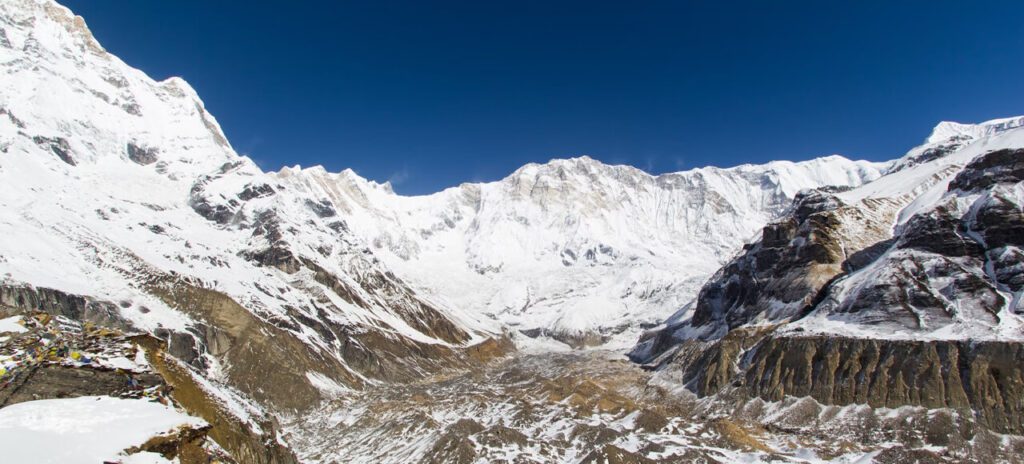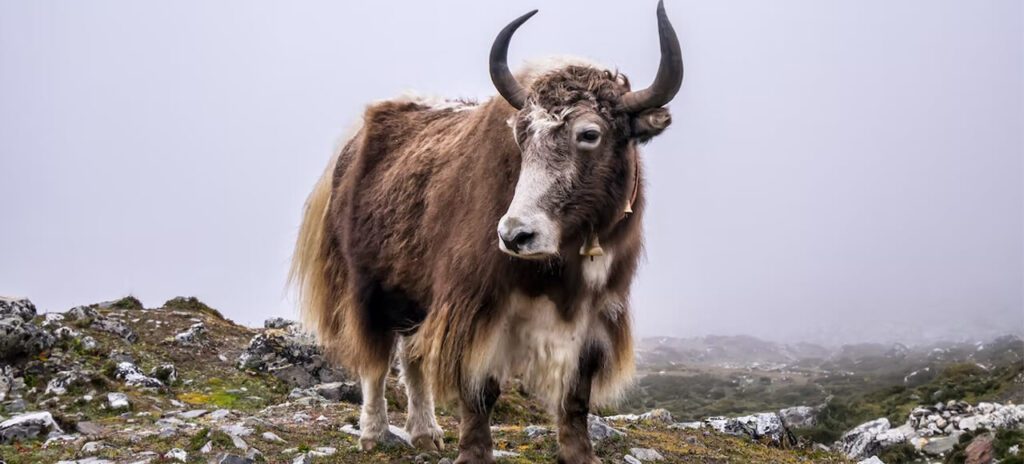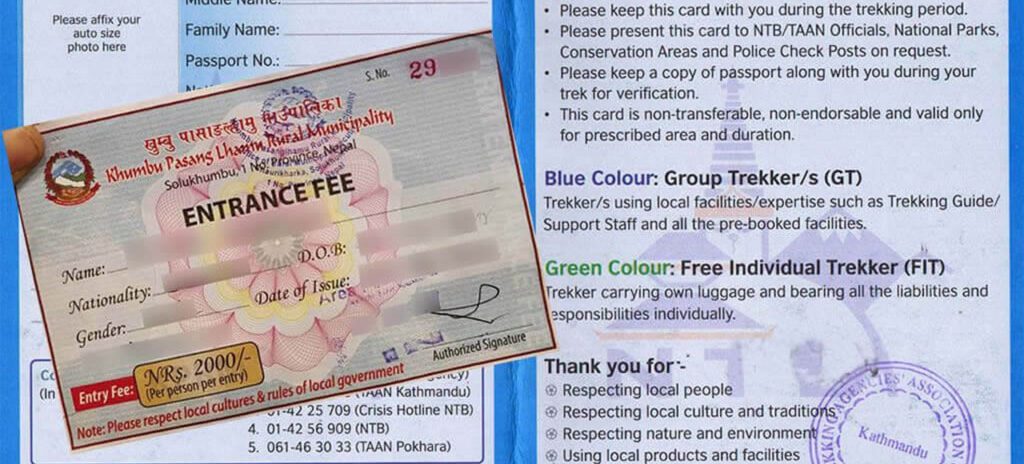Everest Base Camp vs. Annapurna Base Camp. One of the biggest trekking destinations in the nation is Everest Base Camp, which is situated in the Khumbu region of Nepal. The South Base Camp in Nepal and the North Base Camp in Tibet make up this structure. The Lukla airport is the gateway for about 40,000 visitors each year who travel 154 kilometers from Kathmandu to the Everest Base Camp.
The Annapurna Base Camp, located 40 kilometers north of Pokhara, attracts many visitors annually with its stunning Himalayan range. Peaks like Dhaulagiri, Machhapuchhre, and Manaslu add to its allure. Exploring the customs of Thakali, Brahmin, Magar, and Gurung groups enriches the experience. This trip offers not just visual splendor but also opportunities to discover lakes and flora. There are 168 kilometers between Kathmandu and the Annapurna Base Camp. The Everest Base Camp is situated at an altitude of 17,598 feet, while the Annapurna Base Camp is located at an altitude of 13,550 feet.
Everest Base Camp vs. Annapurna Base Camp View
View from Everest Base Camp
The view from Everest Base Camp is truly breathtaking. The camp, at 5,364 meters (17,598 feet), provides panoramic views of the Himalayan range, including tallest peaks. Despite harsh conditions, it gets busier during climbing season, with climbers preparing for their ascent.

The view from Everest Base Camp is a truly once-in-a-lifetime experience, offering a glimpse into the rocky beauty and extreme challenges of mountaineering in the Himalayas.
View from Annapurna Base Camp
The Annapurna Base Camp (ABC) is a famous trekking destination in Nepal’s Annapurna Conservation Area. It is located 4,130 meters above sea level and provides breathtaking views of the nearby Himalayan Mountains. From the Annapurna Base Camp, you can see the panoramic views of Annapurna South, Annapurna I (8,091 m), Hiunchuli (6,441 m), Gangapurna (7,455 m), and Machhapuchhre (6,993 m), among others. You will also get to witness the magnificent sunrise and sunset over the Himalayas, which is truly a once-in-a-lifetime experience.

Visitors can witness the diversified flora and fauna of the Annapurna Conservation Area, along with stunning mountain views. Over 100 mammal species, over 450 bird species, and numerous reptile, amphibian, and insect species live in the area. You can also witness the traditional lifestyle and culture of the local Gurung and Magar communities.
Transportation
Everest Base Camp
Reaching Everest Base Camp:
The journey to Everest Base Camp typically starts with a flight from Kathmandu to Lukla, a small town located in the Khumbu region of Nepal. The flight is approximately 30 minutes and offers stunning views of the Himalayas. However, due to unpredictable weather conditions, flights can be delayed or canceled, so it’s important to keep some buffer days in your itinerary.
Also Check: An Overview of Everest Base Camp
From Lukla, visitors begin the trek to Everest Base Camp, which takes around 8-10 days depending on the pace and route taken. The trek involves hiking through rugged terrain and steep uphill climbs, crossing suspension bridges over rivers, and staying in local tea houses along the way. The trek can be physically demanding, but the stunning views of the Himalayan landscape make it all worthwhile.
Exploring Everest Base Camp:
Once you reach Everest Base Camp, there are no motorized vehicles allowed. This is to protect the fragile ecosystem of the region and minimize the impact of human activity on the environment. All exploration within the base camp area and surrounding mountains is done on foot.
Porters and Yaks:
For those who prefer not to carry their own gear, it’s possible to hire a porter to carry their belongings. Porters are local residents who are familiar with the terrain and can carry up to 30kg of luggage.

Yaks and dzo are also used to transport goods and supplies in the region.
Helicopter Tours:
A helicopter tour of the Everest area is available for those with limited time or physical ability. Helicopter tours provide tourists with breathtaking aerial views of the Himalayas, allowing them to see the base camp and nearby peaks without having to trek for several days. Helicopter tours, on the other hand, can be quite expensive and are not a practical choice for most visitors.
Annapurna Base Camp
- Private Car/Jeep: One option is to hire a private car or jeep to take you directly to the trailhead. This option is more expensive but also more comfortable and convenient.
- Public Bus: Another option is to take a public bus from Pokhara to Nayapul, which is the starting point for the Annapurna Base Camp trek. From Nayapul, you can either trek or take a jeep to the base camp.
- Shared Jeep: You can also take a shared Jeep from Pokhara to Nayapul or to other parts of the trek. Shared jeeps can be crowded and uncomfortable, but they are a cheaper option than hiring a private car.
- Helicopter: If you have the budget, you can also take a helicopter to Annapurna Base Camp. This option is more expensive, but it provides a breathtaking view of the mountains and saves time.
Permit
Permit for Everest Base Camp
The Everest Base Camp Permit is a document that grants trekkers and mountaineers access to Nepal’s Everest region. Before embarking on an Everest Base Camp trek, obtaining this permit is mandatory. It grants access to restricted areas. These areas include Sagarmatha National Park and the Everest Conservation Area. To obtain an Everest Base Camp Permit, you must apply through an authorized trekking agency or tour operator in Nepal.
Permit fees fluctuate; peak season (September to November) costs more than off-season (December to August). In addition to the Everest Base Camp Permit, trekkers require permits for Sagarmatha National Park and Khumbu Pasang Lhamu Rural Municipality. These permits ensure legal access to the restricted areas.

Foreign tourists, including those from SAARC countries, must pay NPR 2,000 per individual for a four-week permit from the Khumbu Rural Municipality. After the first four weeks, the permit costs NPR 2,500 per individual. Tourists must have their passports with them while applying for this permit.
As for the Sagarmatha National Park Entry Permit, foreign nationals are required to obtain an entry permit and pay a fee of NPR 3,000 per person. The authorities charge SAARC nationals NPR 1,500 and Nepalese citizens NPR 100, with a 13% VAT included. Children under the age of 10 can enter for free. Please ensure that you have your passport with you when obtaining the permit.
Also Read: Everest Base Camp Route – From Tenzing Hillary Route to Heli Ride
Permit for Annapurna Base Camp
The Annapurna Base Camp trek is one of the most popular trekking spots in Nepal. To access the trek, trekkers are required to obtain a permit from the Annapurna Conservation Area Project. All trekkers entering the Annapurna region must obtain the ACAP permit, aimed at conserving its natural and cultural heritage. The permit fee is used to maintain trekking trails, fund conservation projects, and support local communities’ livelihoods.

In addition to the ACAP permit, trekkers are also required to obtain a TIMS (Trekkers’ Information Management System) card. The TIMS card is a trekking information management system that records details about trekkers and their trekking routes. Trekkers must provide details like full name, passport information, itinerary, and duration of stay to obtain necessary permits. The permits can be obtained in Kathmandu or Pokhara before starting the trek.
Challenges Everest Base Camp vs. Annapurna Base Camp
Everest Base Camp
Although trekking to the Everest and Annapurna Base Camps is an enjoyable and exciting experience, it can also be quite challenging. Altitude sickness is a common challenge that many tourists face due to the low oxygen levels at higher altitudes. Another obstacle is the possibility of flight delays or cancellations at Lukla Airport, also known as Tenzing Hillary Airport, which serves as the gateway to the Everest Base Camp.
This airport is always busy, especially during peak season, when a large number of tourists fly from Kathmandu to Lukla every day. Additionally, climate conditions can also pose significant challenges. Foggy weather can lead to flight cancellations, and heavy rains during the summer season can make the path more slippery, hindering the enjoyment of the view.
Annapurna Base Camp
Similarly, trekking to Annapurna Base Camp can also pose challenges due to the high altitude and unpredictable weather, which may lead to altitude sickness and other difficulties. However, the stunning and up-close views of mountains like Annapurna, Machhapuchhre, Dhaulagiri, and Manaslu make it a thrilling experience. Machhapuchhre, also known as the sacred mountain in Hinduism, and Dhaulagiri, the seventh-highest mountain in the world, are among the awe-inspiring sights to behold. Manaslu, the eighth-highest mountain in the world, can also be viewed from the Annapurna Base Camp.
Although both treks provide breathtaking views of the Himalayas, Mount Everest cannot be seen from Annapurna Base Camp. Instead, trekkers can enjoy the breathtaking scenery of the surrounding mountains, as well as the local biodiversity and culture. Similarly, Mount Everest cannot be seen from Everest Base Camp because the towering Himalayan mountains block the view. Furthermore, it takes approximately 40 days to reach Mount Everest’s summit from the base camp, which is 7.2 kilometers away.
The Cost of Trekking Everest Base Camp vs. Annapurna Base Camp
Trekking is a must-do activity if you’re planning a trip to Nepal and want to have an adventurous experience. Reaching the summit of Mount Everest is a once-in-a-lifetime goal for many. However, there are also other exciting treks like Everest Base Camp and Annapurna Base Camp. Since these are Nepal’s most renowned trekking destinations, I have financial tips to enhance your trek’s affordability.
Everest Base Camp Cost:
Trekking to Everest Base Camp is a popular and crowded route, with costs varying from $800 to $5000 per person. Factors like accommodation and trek duration influence pricing. These expenses can vary widely depending on your specific needs and preferences.
Annapurna Base Camp Cost:
Annapurna Base Camp Trek is comparatively more affordable than Everest Base Camp. The cost per person for this trek usually ranges from $700 to $1000 but can vary depending on factors such as your preferred accommodation and the level of services you require during your trekking period.
Best Time to Travel Everest Base Camp vs Annapurna Base Camp
Everest Base Camp
The optimal seasons for visiting Everest Base Camp are from March to May or mid-September to November. These time frames offer favorable trekking conditions, including excellent visibility and relatively stable weather. By trekking during these periods, you can experience less snow and avoid the potential challenges posed by monsoon rains. Taking advantage of this opportunity can provide a rejuvenating respite from the stresses of everyday life and help you feel more fully alive.
Annapurna Base Camp
October stands out as the optimal time for visiting Annapurna Base Camp. However, September to November also offers suitable trekking conditions. Additionally, the spring season is considered the best time to visit Annapurna Base Camp. It offers stunning views of blooming flowers, adding to the natural beauty of the region. Trekking during these periods can provide a refreshing escape from daily stresses and help you recharge your energy levels.
Trip Duration Everest Base Camp vs Annapurna Base Camp:
Everest Base Camp:
Completing the Everest Base Camp Trek typically requires 12 to 14 days, during which you may experience mental and physical exhaustion. However, this journey offers a wealth of fascinating experiences, including the opportunity to explore Sherpa culture and cuisine. Sherpa cuisine utilizes organic, locally-sourced ingredients like potatoes, barley, and buckwheat.
Along the way, explore monasteries, stupas, and the charming town of Namche Bazar, renowned for homemade butter and cheese. Enjoy stunning mountain views. Renowned for its hospitality and traditions, this town offers delightful experiences for strolling, shopping, and immersing in local culture. Furthermore, the trekking path is a highlight, with breathtaking views of monasteries, stupas, landscapes, and prayer flags along the way. Finally, you’ll have the opportunity to take in the awe-inspiring Himalayan lakes, making this journey an unforgettable experience.
Annapurna Base Camp:
Trekkers typically complete the Annapurna Base Camp trek in 6 to 12 days. It ranks among Nepal’s most beloved routes, offering breathtaking Himalayan views. The journey commences in the lively city of Pokhara. While there, you can enjoy activities like boating on Phewa Lake, as well as paragliding and zip-lining.
Additionally, you’ll have the opportunity to learn about the local ethnic groups, including the Gurung, Magar, Thakali, and Brahmin communities. During your journey, you can make a stop at Ghandruk, one of the most beautiful villages in the region, which offers stunning views of Mt. Annapurna, Mt. Machhapuchhre, and Mt. Hiuchuli. Ghandruk also serves as the gateway to Poonhill. Furthermore, the trekking route offers a diverse range of flora and fauna, as well as the chance to see high mountain lakes like Tilicho Lake (4991 m), making this journey a true adventure.
Conclusion
Both the Everest Base Camp and Annapurna Base Camp treks have become extremely popular among domestic and international tourists alike. Both offer stunning views of mountains, lakes, and diverse flora and fauna, as well as the opportunity to experience local cultures. However, the Annapurna Base Camp trek may be slightly easier in comparison to the Everest Base Camp trek. The Annapurna Base Camp trek takes between 6 and 12 days to complete, while the Everest Base Camp trek can take up to 12 to 14 days.
The Annapurna Base Camp route is also lower in altitude and contains more forests and greenery, making it a well-manicured and well-managed trekking path. While the Everest Base Camp trek can be physically demanding, the Annapurna Base Camp trek can be completed by those who are physically fit without too much challenge. However, as every person’s body reacts differently to new environments, this may not be the case for everyone. In summary, the Annapurna Base Camp trek may be considered easier than the Everest Base Camp trek for those who are physically fit and looking for a less challenging trekking experience.
Let our expert team at Asian Heritage Treks and Travel take care of everything — from guided tours to personalized packing tips and travel arrangements.
Plan My Everest Trip







